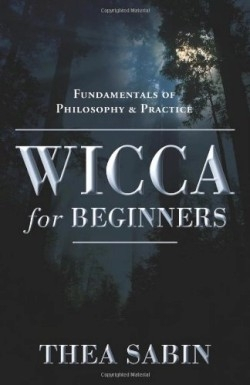Wicca for Beginners
Fundamentals of Philosophy and Practice
Wicca is not just about magic. Wicca is a religion, a “New-Old” religion that entered the radar of the general population during the 1950s, when Gerald Gardner wrote The Meaning of Witchcraft and popularized the term “Wicca.”
So what do Wiccans do? The Wiccan religion is less concerned about what happens after death than other religions. The author states, “Wiccans focus on participating in the cycle of life, here and now.” Sabin, who was initiated into a British Traditional path after a long formal training and now holds a high rank in that tradition, offers an engaging and intimate guide to the path of Wicca. Readers who are hesitant to seek out a coven for training will appreciate the way this book, the author’s first, takes them straight inside Wicca in a manner that is direct and specific.
The intimate tone of this guide allows readers to master each exercise, through Sabin’s coaching and her self-disclosure of some of the results she has experienced. For example, at a large open circle ritual among Wiccans she did not know, everyone had to “ground” the energy that would be raised. She had taught her students to use a visualization of a root growing from the base of their spine. The author confides, “I could feel the “taproots” of all my students shoot into the ground … it was a little bit like dominos falling in a row.” She goes on: “some of the other ritual participants who were not in our group could feel it too, by the funny looks they gave us.”
Using Sabin’s exercises, readers will have immediate experience of some of the tools that Wicca employs. One exercise, titled “hand to hand,” teaches the reader how to start experiencing energy by sitting quietly, rubbing the hands together lightly several times, and then slowly pulling them apart, feeling the energy “zip between” the palms or fingers. Another exercise, “stones and sticks,” invites the reader to take a variety of stones and hold each of them in the non-dominant hand, which is the “receiving hand.” By doing this, the reader can experience differences in the energy of each stone. Feeling a stone’s energy is not about the temperature or texture of the stone; it is a subtle sense and can be different for each reader. Once the sensing of energy in stones has been mastered, the reader graduates to feeling the energy of plants and trees, holding the hands a small distance away and seeing how each plant or tree feels, sensing the “energy signature” of each.
Many further essentials of Wiccan practice are more easily grasped, and what the reader experiences is “owned,” as Wicca is a mystery religion. There is a structure underlying what is seen, heard, or touched, an invisible girding that holds the world of form together. Wiccans seek to know this structure, by “attuning to and understanding” these patterns. Throughout her book, the author shows that Wicca is not just a religion that is practiced. It is a religion that is lived.
Reviewed by
Carol Lynn Stewart
Disclosure: This article is not an endorsement, but a review. The publisher of this book provided free copies of the book to have their book reviewed by a professional reviewer. No fee was paid by the publisher for this review. Foreword Reviews only recommends books that we love. Foreword Magazine, Inc. is disclosing this in accordance with the Federal Trade Commission’s 16 CFR, Part 255.

